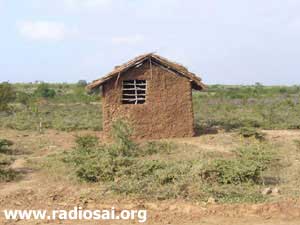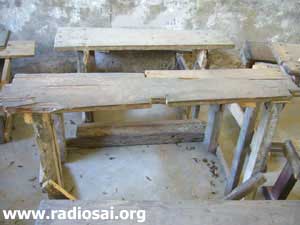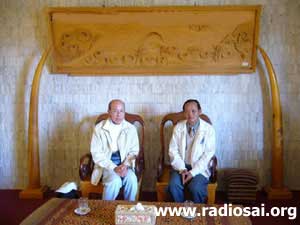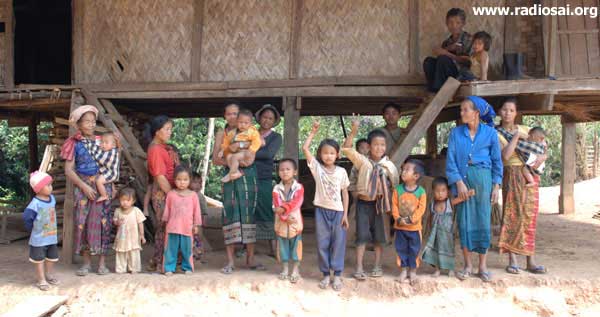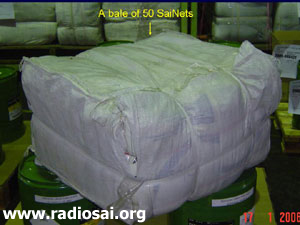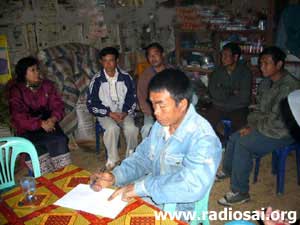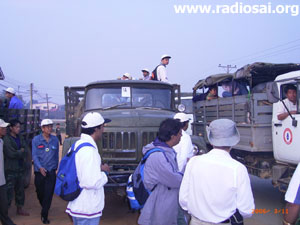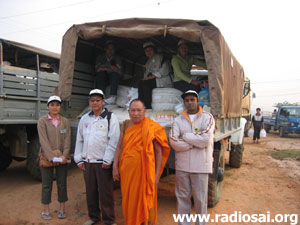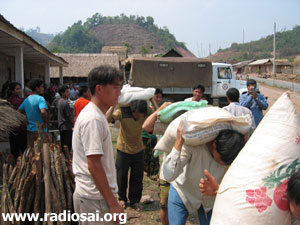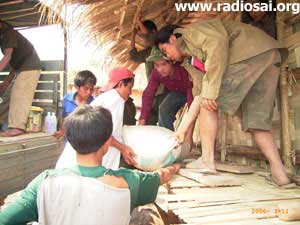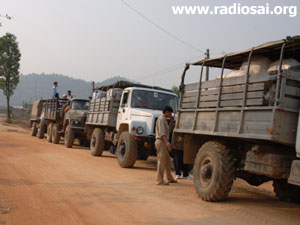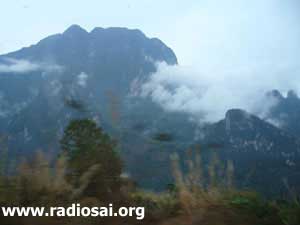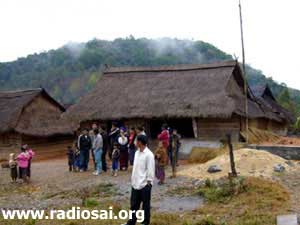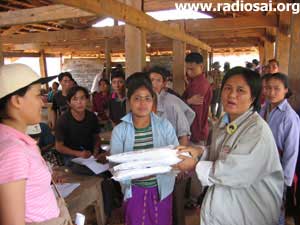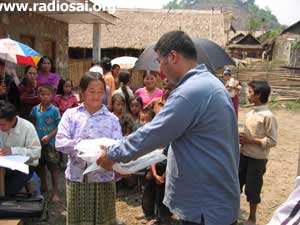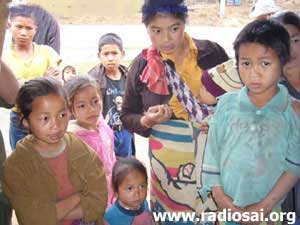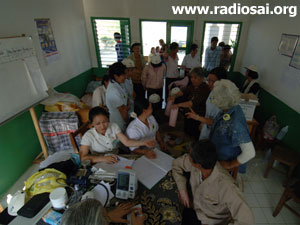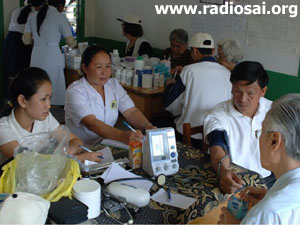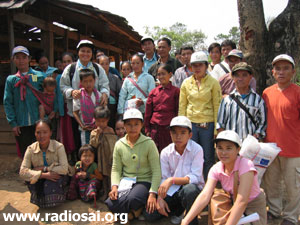 |
 |
 |
 |
| Volume 4 - Issue 08 AUGUST 2006 |
|
SPREADING THE NET OF HIS LOVE IN LAOS SAINET PROJECT IN LAOS Motivation
Investigation and Early PreparationBro. Prof. Yeoh planned a visit to Laos in October 2005 to meet with the Sai Organization there to investigate the need for Malaria prevention in Laos and other needs of the people there. During his visit to Vientiane, he met with Bro. Avi Sarkar from the Lao Sai Organization and Lao Government officials as well as the Singapore Ambassador to Laos. The Lao Sai Organization was very enthusiastic and offered its full support. The Singapore team learnt that:
Bro. Prof. Yeoh returned to Singapore and started a detailed planning process to procure and deliver the nets and food aid to the inaccessible villages of Laos. This had to be completed before March 2006. That way, the programme could still be executed during the 80th Year of the advent of the Divine Avatar. It was decided that the project would be undertaken by Sathya Sai Social Service, Singapore, which has extensive experience in undertaking social service projects. The Trip to KenyaIn January 2006, Bro. Prof. Yeoh visited Kenya to participate in the project and receive first-hand appreciation of the Sainet project in execution and to learn from the Kenyan experience. He came back with a lot of information on the detailed operational planning of the Sainet operation.
After this trip, the Singapore team had a lot of ideas how to plan the project in Laos. Detailed planning started in January, and it was felt that another recce (reconnaissance) trip was needed to determine the exact routes, distribution points, and have coordinated joint planning with the Laotian team. The dates for the recce trip were fixed for early February and the final delivery for early March 2006. The Recce Trip Bro. Dr. Yeoh, along with Bros. CS Teng & Loka, made a recce trip on 9 th of February 2006, and met with the Lao Sai organization, the Lao Government officials, and visited the forward areas of distribution. They met the Governor of Xieng Khuang Province and received his support for the project. He also met the UXO Lao officials (the organization responsible for clearing unexploded ordnance), who made heavy-duty trucks available to carry the relief material to the villages. They also met a Buddhist monk, who declared ‘Baba is God’. All of these people enthusiastically supported the project, and he came back with detailed blueprints of the operation. It was decided that the target area for this mission would be in Phoukhout district of Xieng Khuang Province. Dr. Yeoh subsequently signed a Memorandum of Understanding with the Lao Sai Organization and the Government of Lao for the project.
Having surveyed the forward areas, Bro. Dr. Yeoh had some idea of the terrain, lifestyles of the people, and broadly what to expect when the main party of Sevadals reached the forward distribution area. Then the rest of the team was briefed in Singapore.
Final detailed plans were arranged and 5,000 treated, long-lasting nets were purchased. While being more expensive than the normal treated nets, these are ideal for the Laos project, since the villages are so inaccessible. Also, plans were completed to purchase 20 tonnes of rice for distribution in the villages and for transporting them. The team structures were developed. A medical doctor, Dr. Ho Soon Lye, volunteered to accompany the team and conduct a medical camp in the forward areas. He would also serve as the medical officer for the team. Dr. Ho briefed all the volunteers and provided them anti-malarial drugs and a host of vitamins to prepare them for the trip.
The Advance PartyOn 6th of March, Bro. Dr. Yeoh, along with Bro. CS Teng, went to Laos as the advance party to make preparations for the main group. The advance party held final consultations with all concerned and did a physical inventory of the 5,000 nets, 20 tonnes of rice, and 12 heavy-duty trucks that would be used for the delivery. The advance party also held detailed discussions with the truck drivers and other members to study the routes, and made adjustments to the directions and the villages to be covered. The earlier plan to bring the villagers to collection points was dropped and it was decided that the volunteers would go deep into the remote villages to deliver relief at their doorsteps. Once this was done, they made preparations to brief the main party.
The DistributionThe main party, consisting of 22 volunteers from Singapore, left Singapore on 9th March 2006 under the leadership of Bro. Thiagarajan. They reached the forward area (Phon Savanh) on the night of 10th March after a 14-hour bus journey and met with the advance party. They were joined by 60 volunteers and others from Laos and Thailand, besides a number of Lao Government officials and Buddhist monks. The distribution was planned for March 11th and 12th. The volunteers were divided into 12 teams and these teams went in different directions with their route maps and briefs.
Each team carried a pre-determined number of ‘Sainets’ and a tonne of rice per village. They planned to leave very early in the morning, reach the village, complete the distribution within 2-3 hours, and return to base camp in Phon Savanh by night fall. The volunteers sat on top of the rice bags at the back of the trucks—a unique experience for the Singaporeans. When the Singapore team reached the Laotian border, some of the volunteers were not allowed entry by immigration officials. Then all the volunteers prayed together, chanted the Gayatri mantra and again approached the officials. This time, they received approval to enter! The team saw this as Bhagavan’s leela.
Teams 1A (Bros. Karthik & Sujoy, along with Lao and Thai volunteers) and 1B (Bros. Siva and Mathi, along with Lao and Thai volunteers) had the toughest tasks of reaching the most remote villages, traveling on specialized military-spec trucks called GAT66s. They had to travel over 7 hours each way through the most rugged terrain, holding on to rods on the back of the truck, and to their lives! The dirt tracks they traveled through had enough space for one truck, and one mistake by the driver would crash them 3,000 ft down the cliff. They traveled up the mountains, through streams and rivers without bridges. Their satellite communication systems failed to work in the mountainous territory, and they couldn’t communicate with anyone else—even between team 1A and 1B. They felt Swami’s presence all the way and owe their survival to His blessings. The cooked food they carried became spoilt and they had to survive on dry rations. One of the team members, who had served in the Singapore army, felt that this was far tougher than any army expedition he had ever undertaken. All through the journey they experienced continuous bouncing and pounding.
At the village, the team delivered the nets and the food to the villagers. The villagers brought with them their ‘family book’, which contained their details. Based on this, they were given 1 or 2 family-sized Sainets. The rice was delivered to the ‘rice-banks’, which are collectively used by the villagers in emergencies. The whole distribution took under 3 hours. All the villagers assembled to meet the team and were very hospitable. By the time the two teams headed back to base, it was already dark. On the return journey, team 1B’s truck ran out of fuel in the middle of nowhere, and since their communications equipment was not working, they were stranded. Meanwhile, team 1A, which finished early, got delayed on the way when a broken-down truck blocked their way. When they finally were able to proceed, they found the stranded team 1B and rescued them. Had their return not been delayed, they wouldn’t have been able to rescue them. Again, the team members viewed this as Bhagavan’s leela. All through the operations, everyone felt Bhagavan coming to their aid at every stage. Throughout the perilous journey, all the team members were singing bhajans and saying ‘Sairam’.
Next to team 1, teams 2 (Bros. Viva & Raju) and 3 (Bros. Muthu & Steven) had the toughest routes. Bro. Viva noted that the roads were so dangerous that even one mistake would have caused the vehicle to slip into the deep valleys below. The road conditions were so rough that if they didn’t hold on to the rails they could have been bumped off the truck, perhaps into the valley. And holding on to the truck for so many hours all day long was a big challenge for the volunteers. At some points on the way, the gradients were so steep that the volunteers had to alight for the truck to have enough horsepower to pull itself up the slope. After delivery of the nets and rice, the trucks returned empty, and the volunteers were sitting on the bare floor of the truck. The team suffered shortages of food and water, and fuel ran precariously low. Nevertheless, the team’s spirits remained high; the Laotian drivers were excellent, and their faith in Bhagavan kept them going through this dangerous mission. It was gratifying to see the gratitude and happiness on the faces of the villagers at receiving the relief material which they so sorely needed.
Team 3 (Bros. Muthu and Steven) had a unique and difficult experience. Firstly, they also had a very hard and long route. When they finished their distribution of nets and rice, they discovered that the lights on their truck had failed. As it was already getting dark, it was impossible to navigate through the dangerous route back home. So the team was forced to stay back in the village—something they had not prepared for. The villagers were very hospitable, and by nightfall the mosquitoes had arrived in strength. The team members used the Sainets to protect themselves and spent that night sleeping on mats in huts without any amenities. They had run out of bottled water and had to drink the village water. Thus, this team was not only exposed to the perils of the journey but also to health risks. It was only through Bhagavan’s grace that they all remained safe.
Team 4 (Bros. Ramesh & Vijay) and Team 5 (Bros. Priveen) had similar experiences to report. They found the villagers to be friendly, dignified, and clean. The officials were very cooperative. Team 6 (Bro. Sathya) and Team 7 (Bro. Kuna) reported communication problems since they didn’t speak Laotian. However, the Lao and Thai volunteers were able to speak with the villagers, and bridge the communication challenge. It was an excellent multinational relief operation and each team complemented the other. Team 8 (Bros. CS Teng, Thiaga and Sis. Shantini) visited villages like Mian, Khoung and Sack, which were closer to Phon Savanh. The team returned to base earlier and waited for the others to return. This team met with villages which are more developed and have electricity and TV.
The Water Project InvestigationThe team had 2 engineers, Bros. Loka and Vashi, who had gone to Laos to investigate the water problem there. They examined the water sources in several villages. There is no public water supply system to these remote villages. The team returned with water samples and suggestions on how to provide water to some of the villages in an inexpensive manner, should the organization decide to launch a future water project in Laos. Recounting a Volunteer’s Experience - As told by Bro. Palghat Sivaramakrishnan
Some LessonsThe team learnt through direct experience how Bhagavan protected them all through their difficult missions. It also helped them improve teamwork. Even though the project was planned for nearly six months, lack of information threw up a lot of surprises. Overall, the team is now in a better position to execute future projects under the umbrella of Sathya Sai Social Service, Singapore. The most important lesson was that when we undertake Swami’s projects, no matter how daunting, Sathya Sai is always there to see us through them safely and successfully. We are grateful to Mr. Sriram of Singapore Sai Organisation for lovingly sharing with us this story and all the telling pictures. – Heart2Heart Team |
||||||||||||||||||||||||||||||||||||||||||||||||||||||||||||||||||||||||||||||||||||||||||||||||||||||||||||||||||||||||||||||||||||||||||||||||||||||||||
| You can write to us at : h2h@radiosai.org |
Vol 4 Issue 08 - AUGUST 2006
|
Best viewed in Internet Explorer - 1024 x 768 resolution. |
DHTML Menu by Milonic. |


